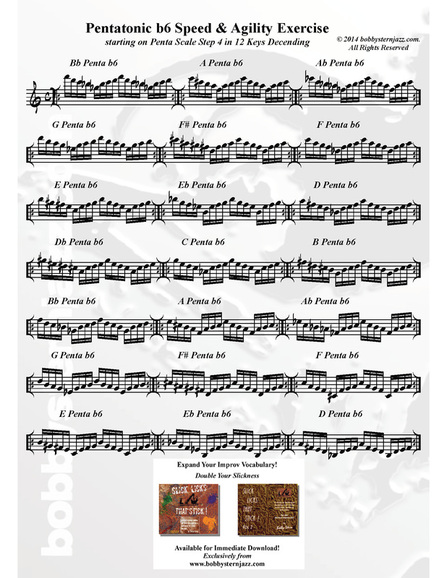NOT Olympics - Pentatonic b6
Speed & Agility Exercise

As with athletics, a musician ultimately measures growth and progress against one's own accomplishments, just as a runner or long jumper might; constantly trying to better the quality of his or her performance.
For the contemporary improvising musician, technical facility on one's instrument makes it possible to express more complex and challenging musical ideas, and is a necessary requirement to do so.
In both disciplines, speed and agility, not only physical, but mental as well, are important acquired skills, obtained through many hours of focused practice` and training, which enhance and augment any innate, natural ability or talent.
It can be used to develop both technical and mental "speed and agility", as well as being a rapid fire way to express a chord or group of chords (a la Joe Henderson, George Coleman, Freddie Hubbard, et al).
Breaking it down - Measure #1 of line 1
:
F-D-C-Bb-Gb is a Bb pentatonic b6, starting on the pentatonic's 4th scale degree (not to be confused with F as the 5th scale degree of a Bb Maj or min scale). Two 4 note groups of 16th notes
(F-D-C-Bb desc. & Gb-Bb-C-D asc.), and you're back to F where you started.
Each subsequent measure is transposed down a half step.
Repeat. Rapid repetition is what this is all about.
Start out` by playing this as slow as you have to in order get it clean! Gradually increase the tempo over time as you get it under control.
Strive to memorize!
Another major point of this exercise is memorization. After playing these configurations enough, you'll probably have them memorized anyway.
This configuration (measure #1) can be used to express the following chords (partial list):
D7#5#9
Ab7#11
GbMaj7+5#11
Bb+7 9
C7sus 9#11
Since Bb pentatonic b6 is derived from the key of Eb Melodic Minor, measure #1 will work over any chords and functions of Eb MM. The same relationships to their parent Melodic Minor keys go for the other transposed measures.
The next logical extension to this exercise would be to begin the configuration on a different scale degree. For example, let's leave the first note F of measure #1 as is but consider it the 3rd scale degree of..................................Db pentatonic b6. This would turn the configuration of bar #1 into F-Eb-Db-A-Ab.
Do the same beginning configuration with the other scale steps, i.e.: 2 = F-Eb-B-Bb-G (Eb penta b6); 1 = F-Db-C-A-G (F penta b6); 5 = F-E-C#-B-A (A penta b6).
This exercise was conceived originally for the tenor saxophone. Trumpet players, trombonists, etc., put it in the range that's comfortable for your instrument.
This isn't about sight reading. It's about memorization, vocabulary and chops building.
See you at the finish line?

 RSS Feed
RSS Feed









